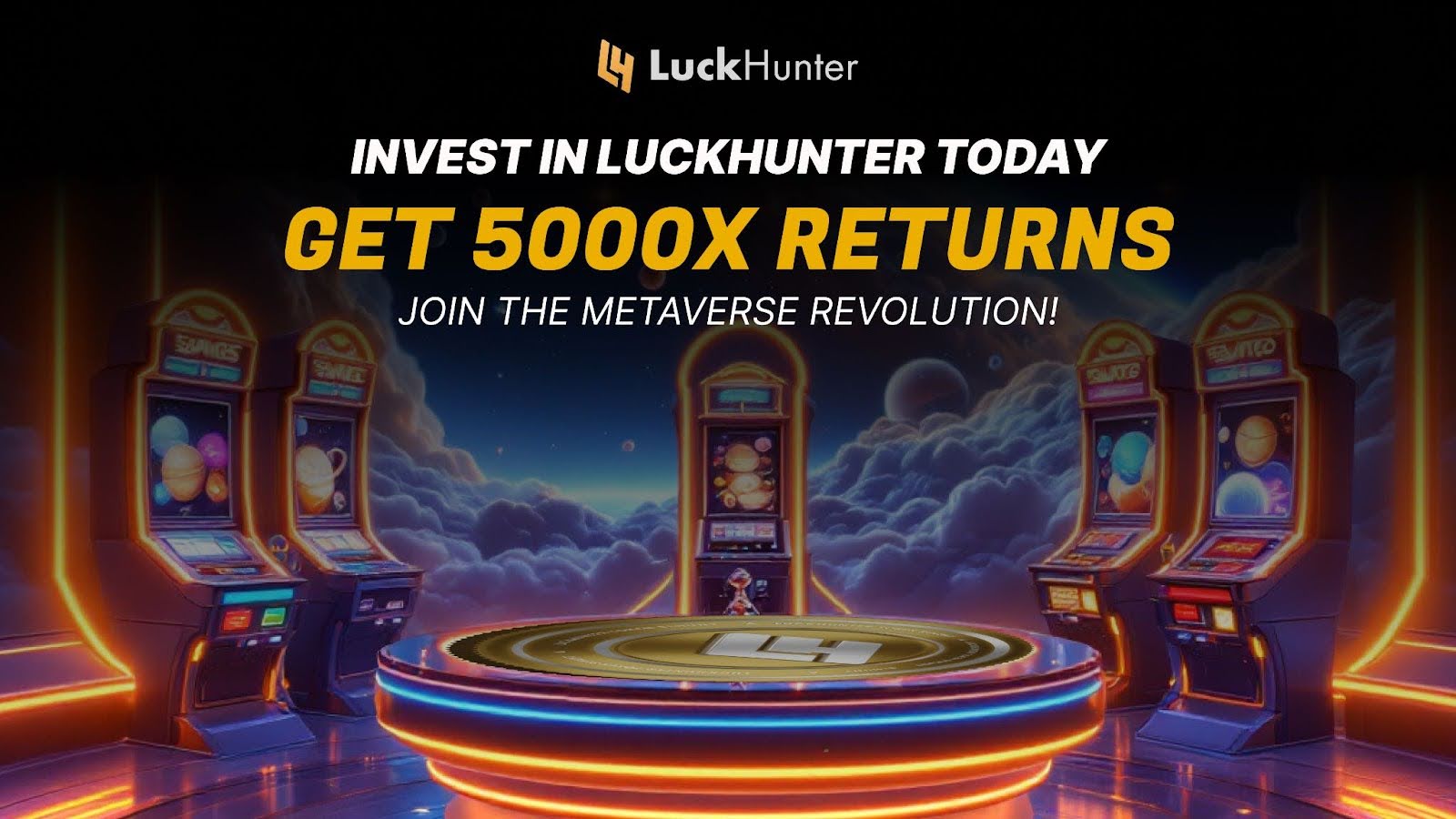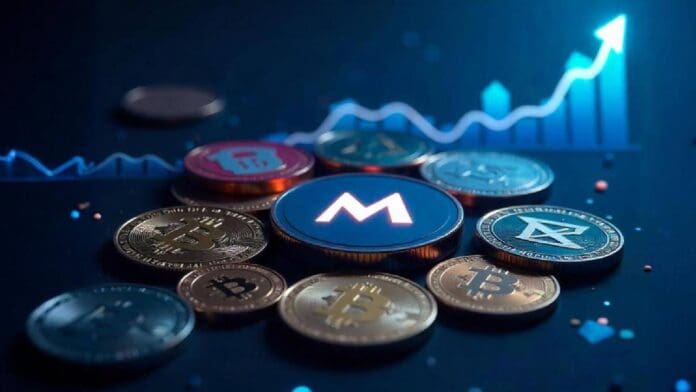XRP’s price has entered a consolidation phase, trading between $2.30 and $2.50, as long-term investors have offloaded approximately $470 million worth of the token recently. Dormant supply circulation rose sharply from 8.3 million to 208 million XRP, reflecting a trend of profit-taking that has dampened bullish momentum. Despite broader market optimism, driven by Bitcoin surpassing $100,000 and favorable regulatory signals, XRP has struggled to break resistance at $2.50. Analysts suggest that if selling pressure continues, the token could face a decline to critical support levels at $2.10 or lower.
Amid such volatility, investors are turning their focus to promising projects with innovative potential and scarcity-driven growth. Among these, LuckHunter—the first metaverse casino gaming platform—stands out as a dynamic opportunity in a rapidly evolving market landscape. Let’s check out more about the five best cryptocurrency to buy now that we have curated as promising investment contenders!

5 Best Cryptocurrency To Buy Now
Below-mentioned is a list of the best cryptocurrency to buy now:
- LuckHunter (LHUNT): A Scarcity-Driven Metaverse Casino Revolution
- Binance Coin (BNB): A Cornerstone of the Crypto Ecosystem
- Polygon (MATIC): Scaling Ethereum for Mass Adoption
- Solana (SOL): High-Speed Blockchain for Decentralized Applications
- Avalanche (AVAX): Accelerating Decentralized Finance and Beyond
Various reasons make them the best cryptocurrency to buy now, such as innovation and market appeal. So, let us dig into the details!
1. LuckHunter (LHUNT): A Scarcity-Driven Metaverse Casino Revolution
LuckHunter has carved a unique niche in the cryptocurrency and gaming industries by integrating blockchain transparency with virtual reality innovation. Positioned as the internet’s first metaverse casino gaming platform, it offers a distinctive approach to gaming and investment.

Click here to explore the LuckHunter metaverse casino >>
Central to its ecosystem is the LHUNT token, designed with a capped supply and a meticulously structured 10-stage presale model. This limited availability has driven early demand, with a consistent price surge at each stage creating a natural appreciation mechanism for investors. Within a short period after its Q4 2024 launch, LuckHunter raised over $1 million, showcasing significant traction and investor confidence.
The 10-stage presale emphasizes scarcity, an essential factor in driving demand. Unlike many crypto projects, which dilute value with over-distributed tokens, LuckHunter’s presale ensures a gradual release of its capped 8.06 billion LHUNT tokens. Each stage introduces a higher token price, rewarding early investors with more favorable entry points while maintaining value for later participants. This structured appreciation model also serves as a hedge against market volatility, offering a predictable growth trajectory for its ecosystem.
Moreover, LuckHunter’s platform extends beyond tokenomics into a fully immersive metaverse experience. Virtual cities like Las Vexus, Hyper Macau, and Tringapore allow users to rent, lease, or own customizable casino tables. These digital assets can generate passive income through gameplay and staking rewards tied to platform activity. By combining ownership opportunities with gameplay transparency powered by blockchain technology, LuckHunter introduces a gaming environment that is both entertaining and financially rewarding.
The global online gaming market, valued at $66.7 billion in 2023, is projected to grow to $227 billion by 2028. This rapid expansion, fueled by blockchain and VR adoption, positions LuckHunter to capture a significant share. The platform’s combination of scarcity-driven tokenomics and innovative gaming experiences ensures its appeal to forward-thinking investors seeking sustainable opportunities in the metaverse economy.
LuckHunter exemplifies a shift in the gaming industry, merging technology, scarcity, and financial transparency to offer a unique investment opportunity. As demand grows and token availability diminishes, the platform’s potential to shape the metaverse gaming landscape becomes increasingly evident.
2. Binance Coin (BNB): A Cornerstone of the Crypto Ecosystem
Binance Coin is the native cryptocurrency of Binance, one of the world’s largest cryptocurrency exchanges. Initially launched as an ERC-20 token on Ethereum, BNB transitioned to Binance’s proprietary blockchain, Binance Chain, in 2019. This move enhanced its utility and established it as a cornerstone of the Binance ecosystem.
BNB has a wide range of applications within and beyond the Binance platform. It is primarily used to pay for transaction fees on the exchange, offering users discounts when they use BNB instead of other payment methods. Additionally, BNB powers Binance Smart Chain (BSC), a blockchain tailored for decentralized applications (dApps) and smart contracts. The growing adoption of BSC has bolstered BNB’s demand, as it is used to cover gas fees within this ecosystem.
A key feature of BNB is its token burn mechanism. Binance periodically burns a portion of the BNB supply, reducing the total number of circulating tokens. This deflationary model aims to increase scarcity and BNB’s value over time.
Beyond Binance, BNB’s versatility allows it to be used for online payments, travel bookings, and even financial services like staking and liquidity provision. Its integration with a rapidly expanding blockchain network and a wide array of applications makes BNB a critical player in cryptocurrency.
3. Polygon (MATIC): Scaling Ethereum for Mass Adoption
Polygon is a Layer 2 scaling solution designed to address Ethereum’s limitations, such as high gas fees and slow transaction speeds. Polygon enhances scalability by creating a more efficient framework for Ethereum-compatible blockchains while maintaining compatibility with Ethereum’s existing ecosystem.
Polygon uses a multi-chain system that employs proof-of-stake (PoS) consensus and plasma sidechains to process transactions off the Ethereum mainnet. This reduces congestion and improves transaction throughput without compromising decentralization or security. The native token, MATIC, plays a central role in the network by facilitating transaction fees, staking, and governance.
Developers are drawn to Polygon for its user-friendly framework and low-cost environment. It supports dApps, decentralized finance (DeFi) projects, and non-fungible tokens (NFTs), making it a go-to platform for many use cases. Projects like Aave and Uniswap have integrated with Polygon to provide users with faster and cheaper platform access.
Polygon’s compatibility with Ethereum and its ability to reduce operational costs position it as a key enabler of Ethereum’s broader adoption. As blockchain technology becomes more mainstream, Polygon continues to evolve, offering innovative tools to developers and end-users alike.

4. Solana (SOL): High-Speed Blockchain for Decentralized Applications
Solana is a blockchain platform known for its high-speed transactions and low fees. It uses a novel consensus mechanism called Proof of History (PoH) in conjunction with Proof of Stake (PoS), enabling the network to process thousands of transactions per second. This efficiency makes Solana an attractive platform for decentralized applications (dApps), DeFi protocols, and NFT marketplaces.
The Solana network has gained traction due to its scalability and ability to handle a high volume of transactions without compromising security or decentralization. Its native token, SOL, is used for transaction fees, staking, and governance. Stakers are incentivized with rewards, contributing to the network’s security and stability.
Solana’s ecosystem hosts many projects, including Serum, a decentralized exchange, and Degenerate Apes Academy, an NFT collection. Its infrastructure supports a vibrant developer community, fostering gaming, finance, and Web3 application innovation.
While Solana has faced occasional network outages, its technological advancements and rapid adoption demonstrate its potential to be a leading blockchain for high-performance applications. As the demand for scalable blockchain solutions grows, Solana remains a strong contender for developers and investors.
5. Avalanche (AVAX): Accelerating Decentralized Finance and Beyond
Avalanche is a blockchain platform for decentralized applications, custom blockchain networks, and enterprise solutions. Its architecture focuses on speed, security, and flexibility, making it one of the fastest platforms in the blockchain space.
Avalanche’s unique three-chain structure—X-Chain, C-Chain, and P-Chain—optimizes functionality. The X-Chain handles asset creation, the C-Chain enables compatibility with Ethereum-based smart contracts, and the P-Chain manages validators and subnets. This modular approach ensures scalability while allowing developers to build customized blockchain networks tailored to specific use cases.
The AVAX token serves multiple purposes within the ecosystem. It is used for transaction fees, staking, and governance. Stakers who validate transactions are rewarded with AVAX, incentivizing active participation and maintaining network security.
Avalanche’s low-latency architecture has made it a popular choice for DeFi applications, enabling protocols like Aave and Curve to operate efficiently. Its interoperability with Ethereum has also contributed to its adoption, allowing users to transfer assets between the two ecosystems seamlessly.
Avalanche’s focus on scalability and its developer-friendly environment position it as a versatile platform for DeFi, enterprise solutions, and beyond. As blockchain technology evolves, Avalanche continues to refine its infrastructure to meet the demands of a global, decentralized economy.
Conclusion On The Best Cryptocurrency To Buy Now
As the cryptocurrency market continues to evolve, investors are exploring innovative projects that combine technological advancements with strong market potential. Binance Coin (BNB) remains a cornerstone of the crypto ecosystem, offering extensive utility within and beyond the Binance platform.
Moreover, Polygon (MATIC) is tackling Ethereum’s scalability challenges, positioning itself as a crucial enabler of mass blockchain adoption. Solana (SOL), with its high-speed infrastructure, has emerged as a go-to platform for developers focused on decentralized applications and NFT marketplaces. Avalanche (AVAX), with its unique architecture, is driving innovation in DeFi and enterprise solutions, offering scalability and flexibility for a wide range of use cases.
In addition, projects like LuckHunter (LHUNT) are leveraging scarcity-driven tokenomics and metaverse innovation to capture attention in rapidly growing industries like gaming. Thus, it stands as the best cryptocurrency to buy now.
Besides, as blockchain adoption expands across diverse sectors, these cryptocurrencies exemplify the potential to lead in their respective niches, providing both developers and investors with compelling opportunities in the digital economy.
Disclaimer:
This page contains sponsored content provided by an external source. The content is for informational purposes only and should not be considered financial or investment advice. The views expressed are those of the sponsor or author and do not necessarily reflect the opinions of NewsWatchTV. Readers are strongly encouraged to conduct independent research and consult with a financial expert before making any investment decisions. NewsWatchTV is not responsible for the accuracy of the information provided or any losses or damages arising from reliance on this sponsored content.





